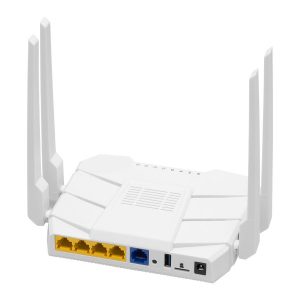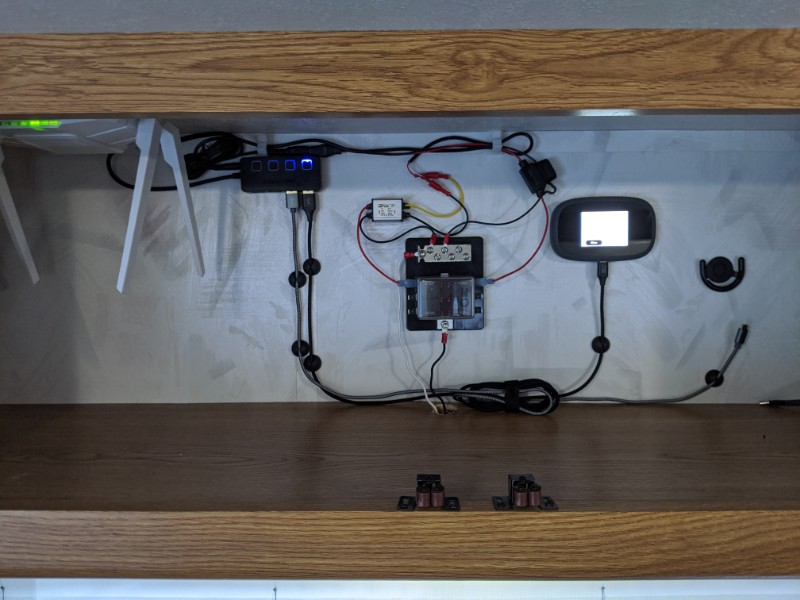Our connectivity goals are ambitious, intended to make it possible to take our home-based business on the road for extended periods. But we also want to utilize smart devices where possible, for lighting, streaming entertainment, etc. Our connectivity goals are:
- 24/7 internal wifi and ethernet network;
- reception and amplification of public wifi signals;
- cellular connectivity;
- redundancy in connectivity options with automatic failover;
- mostly if not totally operational while moving;
- operational under both AC and DC power;
- able to support smart devices (lights, TV, Google Home, etc.)
This page explains our ever-evolving system for connectivity. You will find articles about specific devices and projects in the Connectivity category.
Devices Currently in Our System

- WifiRanger Aspen (indoor mobile router)
- WifiRanger Everest (rooftop router)
- Inseego MiFi 8800L hotspot (Verizon)
- Inseego MiFi 2000 hotspot (Calyx/T-Mobile)
- Sabrent 4-port powered 3.0 USB hub
- DROK DC Buck volt converter (12v to 5v 15w 3A)
- 6-way blade fuse box
- USB cables
- Google Pixel 2 XL smartphone
- NetGear MIMO antenna
Data accounts
- Verizon hotspot account
- T-Mobile unlimited hotspot account
- Calyx Institute T-Mobile Unlimited account
- Google Fi unlimited account
The Aspen mobile router is powered by 12VDC and serves as the central hub for the setup. The USB hub is powered by 12VDC, stepped down to 5VDC by the converter, and connects to the Aspen. On the roof is the WifiRanger Everest, an outdoor router with a 2-mile maximum range; 2.4GHz / 5.8GHz WiFi; and two LTE modems. One of the modem slots contains a SIM for a T-Mobile unlimited account.
Tethered to the Aspen via USB are the MiFi 8800L hotspot (Verizon) and the MiFi 2000 hotspot (Calyx/T-Mobile). Also tethered is the Pixel smartphone (it hangs from the PopSocket holder to the right in the pic below). The powered hub keeps the tethered devices charged. Because all devices are powered by the RV’s batteries or solar, they are always on without the need for the generator or shore power.

The MiFi 8800 hotspot is currently on an unlimited share plan at $10 for the device. The MiFi 2000 hotspot is powered by Calyx Institute’s unlimited T-Mobile account. The membership is pretty pricey ($175 per quarter or $500 per year) so this is probably a bit of overkill unless you’re full-timing (which we are not… yet!).
Google Fi
Google Fi is Google’s entry into the cellular market. Fi is an MVNO (“mobile virtual network operator”) which basically means that they don’t operate their own cellular network but piggyback off of existing networks. For Fi, those are currently T-Mobile and U.S. Cellular. Compatible phones will switch seamlessly between the two networks, to whichever is strongest at the moment. You also get seamless access to a large number of publicly-available wifi networks. Google Fi will bypass any welcome page, logging you in automatically. And you don’t have to worry about security; compatible phones include an always-on VPN. (Non-compatible phones will work, but only on the T-Mobile network with no network switching, wifi hotspots or VPN, although the VPN can be enabled on some phones via an app.)
With the “Unlimited Plus” plan, Google Fi charges you $45 a month for up to 50 GB. After 50, data speeds can be slowed to 2G speeds (256 kbps).
Previously, I tethered my Pixel 2 XL on Fi as needed but the daughter’s 3 XL became available (she switched to iPhone… I thought I raised her better) so I added that phone to the Fi account and dedicated it to the RV’s system. (This also gives the RV its own phone number!)
Performance
The Aspen/Everest router combo allows us to pick the strongest wifi source in a park with multiple access points, or to connect to an access point with less traffic.
Besides receiving and redistributing wifi and/or cellular service to the RV, the router’s wifi network allows us to connect a Google Home Mini, Phillips Hue lights, a Wyze cam, Chromecasts and an Amazon Fire Stick on the TVs.
Obviously, your experience will vary and these numbers don’t really mean much, but here are the download speeds that we have clocked with this system:
- 65-75 Mbps with Google Fi (on T-Mobile) sitting in our storage yard
- 5-8 Mbps with the Verizon hotspot in the same location
The Calyx/MiFi 2000 hotspot is turning out to be our go-to data account. Not only does it offer truly unlimited data but the hotspot is a super-reliable device, even while enclosed in the cabinet with no MIMO antenna attached.
Downsides
I haven’t done enough “real world” testing to identify weaknesses yet. Anticipated weaknesses are source redundancy and signal collection/amplification, both to be addressed by the “future expansion” if necessary.
Cost
- Total hardware cost to date = Approx. $1,000
- Unlimited Sprint (Calyx) = $500 per year
- Monthly data cost = Up to $90 for 150GB+/- data before possible management
Notes
- The components are mounted to the cabinet wall with Nano tape; no holes have been drilled (so far) except to run power to the system from the light fixture under the cabinet.
- 05/20/2020 – Currently, only the USB hub is powered by 5VDC, so it is the only device connected to the converter. Before I wire in a Wyze cam, GHome Mini or other device, I will add a second fuse box to the 5VDC circuit.